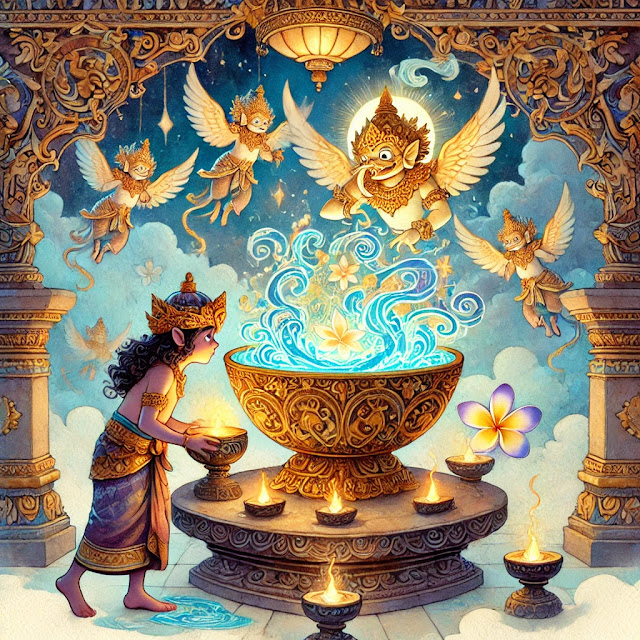Kala Rau: The Stolen Immortality and Its Price
Edisi Bahasa Indonesia: Kala Rau
In Balinese mythology, Kala Rau is known as an evil spirit that exists only as a head without a body. He is not merely a terrifying figure but also a symbol of ambition that exceeds its limits. Born as an asura from the lineage of Wipracitti and Singhika, Kala Rau grew up with deep envy toward the gods, who possessed immense power and eternal life. To him, immortality was not just a desire—it was an obsession. He believed that with eternal life, he could rule the universe and challenge the gods’ dominance.
However, despite his intelligence, Kala Rau also embodies the consequences of greed and deception. His relentless pursuit of immortality led him to defy cosmic laws and trick the gods, but instead of achieving his ultimate goal, he was cursed with a fate worse than death—an immortal existence without a body, haunted by endless rage and vengeance. His giant head, forever chasing the sun and the moon, became a symbol of an unending cycle where darkness constantly seeks to swallow the light but never truly prevails.
The story of Kala Rau teaches that unchecked desires can lead to destruction. He serves as a reminder that in life, ambition without wisdom brings only suffering, and the balance between desire and destiny must always be maintained.
Sin and Punishment
Kala Rau was born from a lineage of giants—the son of Wipracitti and Singhika, known for their cunning nature and thirst for power. Learning that the Tirta Amertha, the sacred nectar of immortality, was meant only for the gods, Kala Rau devised a clever plan to steal it. Disguising himself as a god, he infiltrated the sacred ceremony at the Ocean of Ksirarnawa, where the gods churned the cosmic ocean in pursuit of the nectar of life.
However, Sang Hyang Aditya (the sun god) and Sang Hyang Candra (the moon god) noticed something unusual among the divine assembly. Recognizing Kala Rau’s disguise, they quickly alerted Lord Vishnu.
Just as the first drop of Tirta Amertha touched Kala Rau’s tongue, Vishnu swung his divine discus, Cakra Sudarsana, and beheaded him. His body, which had not yet absorbed immortality, instantly fell and perished. However, because his head had already tasted the sacred nectar, it remained alive—cursed to exist forever without a body, consumed by wrath and vengeance.
Eternal Vengeance and the Eclipse
Feeling betrayed by Aditya and Candra, Kala Rau swore vengeance. With his newfound power, he relentlessly pursued them across the sky, attempting to swallow them into darkness. The Balinese people believe that this eternal chase is the cause of solar and lunar eclipses.
However, since Kala Rau exists only as a head without a body, he is unable to fully consume them. Each time he attempts to devour the sun or the moon, they manage to escape and reappear, creating the endless cycle of eclipses that continues to this day.
Philosophical and Cultural Meaning
The tale of Kala Rau is more than just a legend about an evil spirit seeking immortality. It also symbolizes:
-
The Consequences of Greed – Kala Rau desired immortality that was never meant for him. His deception led not to eternal life as he had hoped, but to an eternal curse.
-
Cosmic Balance – The story illustrates the relationship between the sun, the moon, and time itself. The eclipse serves as a reminder that, no matter how strong a force of disruption may be, balance in the universe will always be restored.
-
The Importance of Vigilance and Justice – Aditya and Candra represent justice, uncovering Kala Rau’s deception. This teaches that lies and deceit will ultimately be exposed.
-
The Cycle of Life – The myth also reflects the cyclical nature of existence. Just as Kala Rau forever chases the moon and the sun but never truly succeeds, life follows its own repeating patterns—darkness may come, but light will always return.
Legacy and Historical Traces
This legend has been immortalized in temple reliefs and monuments throughout Bali, including in Taman Ciung Wenara in Gianyar, where Kala Rau is depicted in various artistic forms. Even today, during eclipses, the Balinese people continue the ancient tradition of performing rituals and prayers to calm Kala Rau’s wrath, preserving a heritage deeply rooted in their ancestral beliefs.
Moral Message: Decisions, Consequences, and Divine Justice
The story of Kala Rau teaches that every decision carries consequences, especially when driven by deception and personal ambition. While trickery may seem beneficial in the short term, it often leads to unexpected repercussions.
Kala Rau disguised himself to steal immortality, but his actions did not escape the watchful eyes of the gods. His punishment was not just the loss of his body but an eternal fate as the ruler of eclipses. This reminds us that true wisdom lies not only in seeking personal gain but in understanding the long-term impact of our choices.
.jpg) |
| Giant Head |



















No comments:
Post a Comment